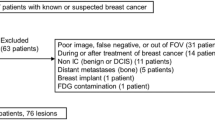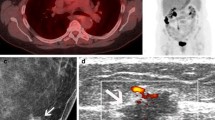Abstract
Objectives
To develop a diagnostic algorithm for positron emission tomography (PET)–detected incidental breast lesions using both breast imaging reporting and data system (BI-RADS) and maximum standardized uptake value (SUVmax) criteria.
Methods
Fifty-six PET-detected incidental breast lesions from 51 patients, which were subsequently investigated by breast ultrasound within 1 month of the PET study, constituted the study cohort and they were finally verified by tissue diagnosis or a 2-year follow-up. Based on the maximum specificity with sensitivity > 60.0% and maximum sensitivity with specificity > 60.0%, two SUVmax cutoff values were calculated at 2 and 3.7. BI-RADS ≥ 4 was considered as highly suspicious for malignancy. The diagnostic accuracies were estimated for SUVmax levels above or below the cutoff points combined with the BI-RADS suspicion level.
Results
Overall, 46 benign and 10 malignant lesions were studied. The diagnostic characteristics of SUVmax ≥ 2, SUVmax ≥ 3.7, and BI-RADS ≥ 4 were 80.0%, 60.0%, and 80.0% for sensitivity, 73.9%, 95.7%, and 92.7% for specificity, and 75.0%, 89.3%, and 90.2% for accuracy, respectively. When the SUVmax threshold was set at 2, combined with BI-RADS suspicion level, the sensitivity, specificity, and accuracy were 100.0%, 69.6%, and 75.0%, respectively. The results for SUVmax threshold set at 3.7 combined with BI-RADS were 90.0%, 91.3%, and 91.1% for the sensitivity, specificity, and accuracy, respectively. A diagnostic algorithm was accordingly generated.
Conclusion
The need for biopsy should be justified in low BI-RADS lesions presenting with high SUVmax at 3.7 or higher. The biopsy of patients with high B-IRADS and low SUVmax could be preserved.
Key Points
• A diagnostic algorithm was developed for PET-detected incidental breast lesions using both BI-RADS and SUVmax criteria.
• Diagnostic performance was calculated separately and conjunctively for SUVmax ≥ 2, SUVmax ≥ 3.7, and BI-RADS ≥ 4.
• The need for biopsy can be justified in BI-RADS < 4 lesions with SUVmax ≥ 3.7. Lesions with BI-RADS < 4 and indeterminate SUVmax (2 < SUVmax < 3.7) benefit from a short-interval follow-up. BI-RADS < 4 lesions with SUVmax < 2 may confidently be scheduled for routine screening.





Similar content being viewed by others
Abbreviations
- BI-RADS:
-
Breast imaging reporting and data system
- F-18 FDG PET/CT:
-
F-18 fluorodeoxyglucose positron emission tomography/computed tomography
- HD:
-
High definition
- PET:
-
Positron emission tomography
- ROC:
-
Receiver operating characteristic
- SUV:
-
Standardized uptake volume
References
Litmanovich D, Gourevich K, Israel O, Gallimidi Z (2009) Unexpected foci of 18F-FDG uptake in the breast detected by PET/CT: incidence and clinical significance. Eur J Nucl Med Mol Imaging 36:1558–1564
D’orsi C, Bassett L, Berg W, Feig S, Jackson V, Kopans DJ (2003) Breast imaging reporting and data system: ACR BI-RADSmammography. 4th edition. American College of Radiology
Mendelson EB, Berg WA, Merritt CR (2001) Toward a standardized breast ultrasound lexicon, BI-RADS: ultrasound seminars in roentgenology. Semin Roentgenol 36:217–225
Lee HJ, Kim EK, Kim MJ et al (2008) Observer variability of breast imaging reporting and data system (BI-RADS) for breast ultrasound. Eur J Radiol 65:293–298
Kolb TM, Lichy J, Newhouse JH (2002) Comparison of the performance of screening mammography, physical examination, and breast US and evaluation of factors that influence them: an analysis of 27,825 patient evaluations. Radiology 225:165–175
Hille H, Vetter M, Hackelöer BJ (2012) The accuracy of BI-RADS classification of breast ultrasound as a first-line imaging method. Ultraschall Med 33:160–163
Kim EK, Ko KH, Oh KK et al (2008) Clinical application of the BI-RADS final assessment to breast sonography in conjunction with mammography. AJR Am J Roentgenol 190:1209–1215
Raza S, Chikarmane SA, Neilsen SS, Zorn LM, Birdwell RLJR (2008) BI-RADS 3, 4, and 5 lesions: value of US in management—follow-up and outcome. Radiology 248:773–781
Naidich DP, Bankier AA, MacMahon H et al (2013) Recommendations for the management of subsolid pulmonary nodules detected at CT: a statement from the Fleischner Society. Radiology 266:304–317
Chen W (2007) Clinical applications of PET in brain tumors. J Nucl Med 48:1468–1481
Lim HS, Yoon W, Chung TW et al (2007) FDG PET/CT for the detection and evaluation of breast diseases: usefulness and limitations. Radiographics 27:S197–S213
Rosen EL, Eubank WB, Mankoff DA (2007) FDG PET, PET/CT, and breast cancer imaging. Radiographics 27:S215–S229
Samson DJ, Flamm CR, Pisano ED, Aronson NJ (2002) Should FDG PET be used to decide whether a patient with an abnormal mammogram or breast finding at physical examination should undergo biopsy? Acad Radiol 9:773–783
Kang BJ, Lee JH, Yoo IeR et al (2011) Clinical significance of incidental finding of focal activity in the breast at 18F-FDG PET/CT. AJR Am J Roentgenol 197:341–347
Hong AS, Rosen EL, Soo MS, Baker JA (2005) BI-RADS for sonography: positive and negative predictive values of sonographic features. AJR Am J Roentgenol 184:1260–1265
Costantini M, Belli P, Ierardi C, Franceschini G, La Torre G, Bonomo L (2007) Solid breast mass characterisation: use of the sonographic BI-RADS classification. Radiol Med 112:877–894
Shin KM, Kim HJ, Jung SJ et al (2015) Incidental breast lesions identified by 18F-FDG PET/CT: which clinical variables differentiate between benign and malignant breast lesions? J Breast Cancer 18:73–79
Chae EY, Cha JH, Kim HH et al (2012) Analysis of incidental focal hypermetabolic uptake in the breast as detected by 18F-FDG PET/CT: clinical significance and differential diagnosis. Acta Radiol 53:530–535
Naseri M, Farzanehfar S, Ranjbar S, Parvizi M, Abbasi MJABC (2017) An overview on positron emission mammography in breast cancer detection and follow up: particular concerns in Iran as a developing country. Archives of Breast Cancer 4:39–41
Beatty JS, Williams HT, Gucwa AL et al (2009) The predictive value of incidental PET/CT findings suspicious for breast cancer in women with non-breast malignancies. Am J Surg 198:495–499
Benveniste AP, Yang W, Benveniste MF, Mawlawi OR, Marom EM (2014) Benign breast lesions detected by positron emission tomography-computed tomography. Eur J Radiol 83:919–929
Bos R, van Der Hoeven JJ, van Der Wall E et al (2002) Biologic correlates of (18)fluorodeoxyglucose uptake in human breast cancer measured by positron emission tomography. J Clin Oncol 20:379–387
Gil-Rendo A, Martínez-Regueira F, Zornoza G et al (2009) Association between [18F] fluorodeoxyglucose uptake and prognostic parameters in breast cancer. Br J Surg 96:166–170
Avril N, Rosé CA, Schelling M et al (2000) Breast imaging with positron emission tomography and fluorine-18 fluorodeoxyglucose: use and limitations. J Clin Oncol 18:3495–3502
Kumar R, Chauhan A, Zhuang H, Chandra P, Schnall M, Alavi A (2006) Clinicopathologic factors associated with false negative FDG–PET in primary breast cancer. Breast Cancer Res Treat 98:267–274
Ueda S, Tsuda H, Asakawa H et al (2008) Utility of 18 F-fluoro-deoxyglucose emission tomography/computed tomography fusion imaging (18 F-FDG PET/CT) in combination with ultrasonography for axillary staging in primary breast cancer. BMC Cancer 8:165
Buck A, Schirrmeister H, Kühn T et al (2002) FDG uptake in breast cancer: correlation with biological and clinical prognostic parameters. Eur J Nucl Med Mol Imaging 29:1317–1323
Shimoda W, Hayashi M, Murakami K, Oyama T, Sunagawa MJ (2007) The relationship between FDG uptake in PET scans and biological behavior in breast cancer. Breast Cancer 14:260–268
Buck AK, Schirrmeister H, Mattfeldt T, Reske SN (2004) Biological characterisation of breast cancer by means of PET. Eur J Nucl Med Mol Imaging 31:S80–S87
Avril N, Menzel M, Dose J et al (2001) Glucose metabolism of breast cancer assessed by 18F-FDG PET: histologic and immunohistochemical tissue analysis. J Nucl Med 42:9–16
Crippa F, Seregni E, Agresti R et al (1998) Association between [18 F] fluorodeoxyglucose uptake and postoperative histopathology, hormone receptor status, thymidine labelling index and p53 in primary breast cancer: a preliminary observation. Eur J Nucl Med 25:1429–1434
Ikenaga N, Otomo N, Toyofuku A et al (2007) Standardized uptake values for breast carcinomas assessed by fluorodeoxyglucose-positron emission tomography correlate with prognostic factors. Am Surg 73:1151–1157
Kim SH, Cha ES, Park CS et al (2011) Imaging features of invasive lobular carcinoma: comparison with invasive ductal carcinoma. Jpn J Radiol 29:475
Adejolu M, Huo L, Rohren E, Santiago L, Yang WT (2012) False-positive lesions mimicking breast cancer on FDG PET and PET/CT. AJR Am J Roentgenol 198:W304–W314
Lee M, Soltanian HT (2015) Breast fibroadenomas in adolescents: current perspectives. Adolesc Health Med Ther 6:159
Korn RL, Yost AM, May CC et al (2006) Unexpected focal hypermetabolic activity in the breast: significance in patients undergoing 18F-FDG PET/CT. AJR Am J Roentgenol 187:81–85
Yoneda A, Lendorf ME, Couchman JR, Multhaupt HA (2012) Breast and ovarian cancers: a survey and possible roles for the cell surface heparan sulfate proteoglycans. J Histochem Cytochem 60:9–21
Funding
The authors state that this work has not received any funding.
Author information
Authors and Affiliations
Corresponding author
Ethics declarations
Guarantor
The scientific guarantor of this publication is Mehrdad Bakhshayeshkaram.
Conflict of interest
The authors of this manuscript declare no relationships with any companies whose products or services may be related to the subject matter of the article.
Statistics and biometry
No complex statistical methods were necessary for this paper.
Informed consent
Written informed consent was not required for this study because the Review Board of Shahid Beheshti University of Medical Sciences waived the need for an informed consent.
Ethical approval
Institutional Review Board of Shahid Beheshti University of Medical Sciences approval was obtained.
Methodology
• Retrospective
• Observational
• Performed at one institution
Additional information
Publisher’s note
Springer Nature remains neutral with regard to jurisdictional claims in published maps and institutional affiliations.
Rights and permissions
About this article
Cite this article
Bakhshayeshkaram, M., Salehi, Y., Abbasi, M. et al. A preliminary study to propose a diagnostic algorithm for PET/CT-detected incidental breast lesions: application of BI-RADS lexicon for US in combination with SUVmax. Eur Radiol 29, 5507–5516 (2019). https://doi.org/10.1007/s00330-019-06106-x
Received:
Revised:
Accepted:
Published:
Issue Date:
DOI: https://doi.org/10.1007/s00330-019-06106-x




